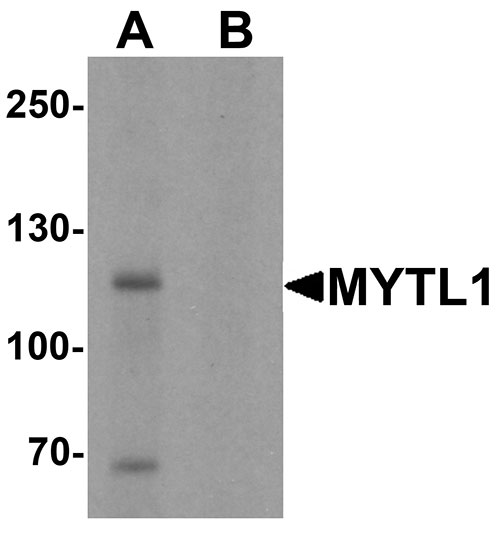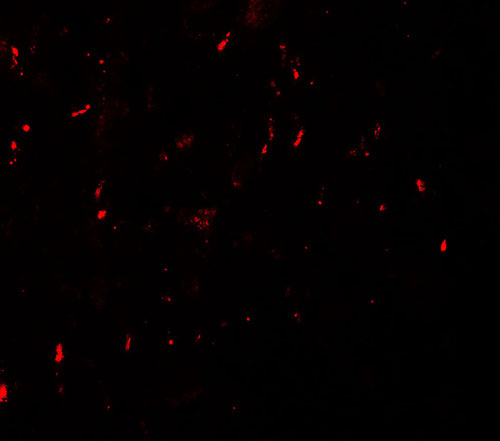MYT1L Antibody
- SPECIFICATION
- CITATIONS
- PROTOCOLS
- BACKGROUND

Application
| WB, IF, E |
|---|---|
| Primary Accession | Q9UL68 |
| Other Accession | NP_055840, 60498973 |
| Reactivity | Human, Mouse, Rat |
| Host | Rabbit |
| Clonality | Polyclonal |
| Isotype | IgG |
| Calculated MW | 130 kDa |
| Application Notes | MYT1L antibody can be used for detection of MYT1L by Western blot at 1 - 2 µg/mL. For immunofluorescence start at 20 µg/mL. |
| Gene ID | 23040 |
|---|---|
| Target/Specificity | MYT1L; At least three isoforms are known to exist. This antibody will only recognize the two longest isoforms. |
| Reconstitution & Storage | MYT1L antibody can be stored at 4℃ for three months and -20℃, stable for up to one year. As with all antibodies care should be taken to avoid repeated freeze thaw cycles. Antibodies should not be exposed to prolonged high temperatures. |
| Precautions | MYT1L Antibody is for research use only and not for use in diagnostic or therapeutic procedures. |
| Name | MYT1L {ECO:0000303|Ref.1, ECO:0000312|HGNC:HGNC:7623} |
|---|---|
| Function | Transcription factor that plays a key role in neuronal differentiation by specifically repressing expression of non-neuronal genes during neuron differentiation. In contrast to other transcription repressors that inhibit specific lineages, mediates repression of multiple differentiation programs. Also represses expression of negative regulators of neurogenesis, such as members of the Notch signaling pathway, including HES1. The combination of three transcription factors, ASCL1, POU3F2/BRN2 and MYT1L, is sufficient to reprogram fibroblasts and other somatic cells into induced neuronal (iN) cells in vitro. Directly binds the 5'-AAGTT-3' core motif present on the promoter of target genes and represses transcription by recruiting a multiprotein complex containing SIN3B. The 5'-AAGTT-3' core motif is absent from the promoter of neural genes. |
| Cellular Location | Nucleus {ECO:0000250|UniProtKB:P97500}. Chromosome {ECO:0000250|UniProtKB:P97500}. Note=Preferentially binds to DNA binding sites that are in an open chromatin configuration {ECO:0000250|UniProtKB:P97500} |

Thousands of laboratories across the world have published research that depended on the performance of antibodies from Abcepta to advance their research. Check out links to articles that cite our products in major peer-reviewed journals, organized by research category.
info@abcepta.com, and receive a free "I Love Antibodies" mug.
Provided below are standard protocols that you may find useful for product applications.
Background
MYT1L Antibody: The myelin transcription factor 1 family, to which the myelin transcription factor 1-like protein (MYT1L) belongs, is expressed primarily in the developing central nervous system and recruits histone deacetylase (HDAC) to regulate neural transcription. Both MYT1L and the related protein MYT1 interact with SIN3B, a protein that mediates transcriptional repression by binding to HDACs, suggesting that the MYT1 family favor the silencing of genes during neural development. Recent studies suggest that polymorphisms of MYT1L may be associated with schizophrenia.
References
Romm E, Nielsen JA, Kim JG, et al. Myt1 family recruits histone deacetylase to regulate neural transcription. J. Neurochem. 2005; 93:1444-53
Li W, Wang X, Zhao J, et al. Association study of myelin transcription factor 1-like polymorphisms with schizophrenia in Han Chinese population. Genes Brain Behav. 2012; 11:87-93.
If you have used an Abcepta product and would like to share how it has performed, please click on the "Submit Review" button and provide the requested information. Our staff will examine and post your review and contact you if needed.
If you have any additional inquiries please email technical services at tech@abcepta.com.













 Foundational characteristics of cancer include proliferation, angiogenesis, migration, evasion of apoptosis, and cellular immortality. Find key markers for these cellular processes and antibodies to detect them.
Foundational characteristics of cancer include proliferation, angiogenesis, migration, evasion of apoptosis, and cellular immortality. Find key markers for these cellular processes and antibodies to detect them. The SUMOplot™ Analysis Program predicts and scores sumoylation sites in your protein. SUMOylation is a post-translational modification involved in various cellular processes, such as nuclear-cytosolic transport, transcriptional regulation, apoptosis, protein stability, response to stress, and progression through the cell cycle.
The SUMOplot™ Analysis Program predicts and scores sumoylation sites in your protein. SUMOylation is a post-translational modification involved in various cellular processes, such as nuclear-cytosolic transport, transcriptional regulation, apoptosis, protein stability, response to stress, and progression through the cell cycle. The Autophagy Receptor Motif Plotter predicts and scores autophagy receptor binding sites in your protein. Identifying proteins connected to this pathway is critical to understanding the role of autophagy in physiological as well as pathological processes such as development, differentiation, neurodegenerative diseases, stress, infection, and cancer.
The Autophagy Receptor Motif Plotter predicts and scores autophagy receptor binding sites in your protein. Identifying proteins connected to this pathway is critical to understanding the role of autophagy in physiological as well as pathological processes such as development, differentiation, neurodegenerative diseases, stress, infection, and cancer.



